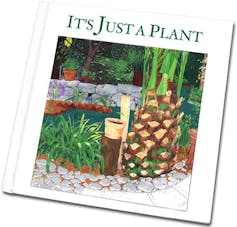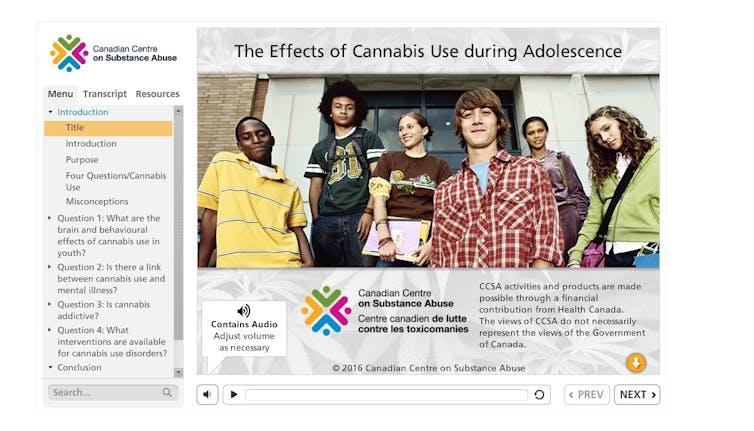Weed, pot, grass, marijuana — or cannabis to use the proper terminology — is now legal in Canada, after 95 years of prohibition. Anyone over the age of 18, or 19 depending on the province, can now walk into a store and buy up to 30 grams of regulated product.
While most Canadians approve of this new policy, many also believe the law will fail to stop more children using the drug and the legal age should be 21. After all, cannabis use among Canadian minors, under prohibition, has been declining over the past decade.
So how should we talk to kids and teenagers about this new legal drug? What can parents do now that legalization is the new reality?
This is a question that I — as a cannabis researcher and father of 18-year-old twin boys — take very seriously, and for good reason. Globally, cannabis is the most available and most used illegal substance. Canadian youth have had some of the highest use rates in the world, even while it was an illegal substance.
The good news is that parents have many tools at their fingertips to protect their children and teens. Here, I offer six steps to help you navigate this tricky terrain.
1. Start family discussions early
The best defence against any kind of drug abuse is knowledge and education. Being properly informed about drugs is central to the harm reduction approach to drugs that is slowly gaining momentum across Canada and other parts of the world.

This approach recognizes that drug abuse is a public health and education problem, not a crime problem. Much of our successes in combating drinking and driving, and reducing cigarette smoking, have come through information and education initiatives.
Education starts at home. And it should begin as early as possible, with age- appropriate language like that used in It’s Just a Plant, a book designed for parents who want to talk to their children about cannabis.
Discussing cannabis with your child should be no different than discussing alcohol and nicotine. A frank conversation about all substances, both legal and illegal, is essential to preventing the abuse of any drug among our youth.
2. Find evidence-based information
Parents do need to educate themselves about drugs, rather than relying on their own personal experiences or media scare stories. There is a great deal of research available on cannabis and other drugs. But this wealth of information can understandably be overwhelming.
Fortunately, there are a number of informative and reliable online sources available to Canadian parents, such as the Canadian Centre on Substance Use and Addiction, Drug Free Kids Canada and the Centre for Addiction and Mental Health.
3. Explain addiction and brain damage
Kids need to know that cannabis is not harmless. And that it has become much more potentover the years. The best decision, like with all legal and illegal substances, is abstinence. Undoubtedly, from a health perspective, if people can get through life without using caffeine, tobacco, alcohol and other drugs, they are better off.
However, because we live in a society saturated with drugs (just check out the beer and pharmaceutical ads on television or the long coffee shop lineups), we need to be pragmatic.
Our children will be exposed to many drugs throughout the course of their lives, including cannabis. They may decide to experiment or use more regularly. So they need to know what the potential harms are, as well as the potential benefits. They also need to know the differences between use and abuse.

While much more research is required, the key health concerns with cannabis are addiction, mental illness, damage to the developing brain, driving while intoxicated and cardiovascular disease.
4. Talk about socializing, creativity and sex
Besides discussing the harms associated with the abuse of cannabis, parents need to have an honest discussion about why people use it — without relying on outdated stereotypes or stigmatizing users. This can be more difficult for parents who don’t use cannabis themselves as they may think that such a discussion will encourage use.
But by explaining why and how people use cannabis, parents can demystify the drug. They can demonstrate that, like alcohol, cannabis can be used responsibly by most people in a variety of social contexts.
This “normalizing” of cannabis reduces its status as a choice for the rebellious. It makes the formerly mysterious and taboo drug rather boring and mundane. This may help explain why cannabis use by youth in Colorado has not increased significantly since the drug was legalized.
So why do people use cannabis recreationally?
For centuries, people all over the globe have used cannabis for many reasons. The research has found that — like alcohol users — most use cannabis as a rational choice to enhance certain activities.
When used properly, it can help with relaxation and concentration, making many activities more enjoyable. Eating, listening to music, socializing, watching movies, playing sports, having sex and being creative are some things some people say cannabis makes more enjoyable.
Sometimes people use cannabis to enhance spiritual experiences or to make mundane tasks like chores more fun. But most importantly, most users recognize that there’s a time and place for use and have integrated it into their lives without forgoing their daily obligations and responsibilities.
5. Teach responsible cannabis use
The responsible use of cannabis is identical to the responsible use of alcohol. The key principles are: understand the effects of
.Many of the health concerns relating to cannabis are associated with heavy chronic use or, in other words, abuse of the drug. As with most things in life, moderation is key. Moderation — in frequency and amount — is important for the responsible use of any substance.
Recent research suggests that many cannabis users, like alcohol users, use responsibly. If parents reinforce the importance of responsible use, their children will be far less likely to suffer the harms associated with cannabis.
6. Just say “know,” not “no!”
History has shown us that the war on drugs has been an abysmal failure. Prohibition hasn’t prevented people — young or old — from using drugs. Prohibition created a black market, gang wars, corruption and dangerous products.
A harm reduction approach to cannabis regulates a safer quality product and focuses on informing people about the potential risks and benefits of cannabis use. Educating our youth about cannabis and responsible use — through talking with them and listening to them — will be far more effective and safer than trying to stop them using it.
When it comes to kids and weed, it’s better to say
than “just say no!”
Author: Professor of Sociology, University of Alberta
credit link:https://theconversation.com/legal-weed-what-your-kids-need-to-know-82481<iframe src="https://counter.theconversation.com/content/82481/count.gif?distributor=republish-lightbox-advanced" width="1" height="1"></iframe>

